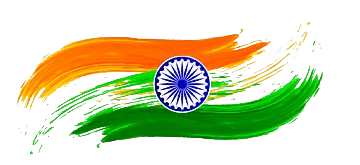- Home
- About Us
- Contact Us
- History
- Home
The Glorious History of Tiranga – India’s National Flag

The Tiranga, meaning Tricolour, is not just a flag – it is the soul of India, representing the unity, pride, and sacrifices of our nation. Every time it waves in the sky, it reminds us of the struggles of freedom fighters and the journey of India towards independence.
Origin of the Tiranga
The story of the Tiranga dates back to the Indian freedom movement when leaders realized the importance of a national flag to inspire people. The first version of the flag was unfurled in 1906 at the Parsee Bagan Square, Kolkata. Over the years, it underwent several changes, but the spirit of independence remained the same.
The Final Design of the Tiranga
On 22nd July 1947, the Constituent Assembly of India adopted the current form of the national flag. Designed by Pingali Venkayya, the Tiranga consists of three horizontal stripes:
Saffron (top) – Symbol of courage, sacrifice, and strength.
White (middle) – Sign of peace, truth, and purity.
Green (bottom) – Represents growth, prosperity, and fertility.
At the center lies the Ashoka Chakra with 24 spokes, symbolizing justice, progress, and the eternal wheel of law.
Significance of the Tiranga
The Tiranga is more than a symbol; it is an identity of every Indian. It stands for:
Unity in Diversity – bringing together people of all religions, cultures, and languages.
National Pride – a constant reminder of India’s sovereignty.
Inspiration – motivating generations to work for peace, progress, and equality.
Tiranga in Modern India
Today, the Tiranga is proudly hoisted on national occasions like Independence Day, Republic Day, and other historic events. It is also displayed in international sports, cultural gatherings, and global platforms, representing the spirit of India to the world.
Tiranga History – The Pride of India’s National Flag
The Tiranga, or Tricolour, is the national flag of India and one of the strongest symbols of our nation’s freedom and unity. It tells a story of courage, sacrifice, and the vision of an independent India. Understanding the history of the Tiranga is not only about knowing its colors and design, but also about honoring the people and movements that gave it meaning.
The Early Stages of India’s Flag
Before independence, India did not have one single national flag. Several versions of flags were used during different phases of the freedom struggle.
1906 – First National Flag: The earliest known flag of India was hoisted in Kolkata (Calcutta) at Parsee Bagan Square. It had three horizontal stripes of green, yellow, and red with symbols of the sun, moon, and Vande Mataram written across it.
1917 – Home Rule Movement Flag: During the Home Rule Movement led by Bal Gangadhar Tilak and Annie Besant, another flag was raised. This version carried the Union Jack in one corner and seven stars representing the Saptarishi constellation.
1921 – The Pingali Venkayya Design: Mahatma Gandhi suggested a flag designed by Pingali Venkayya, featuring two colors – red and green – representing Hindus and Muslims. Later, white was added for other communities, along with the spinning wheel (Charkha) as a symbol of self-reliance.
Adoption of the Final Tiranga
On 22nd July 1947, just before India’s independence, the Constituent Assembly adopted the current form of the national flag. The Charkha was replaced with the Ashoka Chakra, representing eternal law and dharma. This design became the Tiranga we salute today.
Symbolism of the Tiranga Colors
Every stripe of the Tiranga carries deep meaning:
Saffron (Top): Represents courage, strength, and sacrifice made for the nation’s freedom.
White (Middle): Symbolizes peace, truth, honesty, and purity of thought.
Green (Bottom): Stands for growth, prosperity, and the fertility of Indian soil.
Ashoka Chakra (Center): The navy-blue wheel with 24 spokes represents progress, justice, and the eternal motion of life.
Tiranga in India’s Freedom Struggle
The Tiranga was not just a flag but a movement in itself. During rallies, protests, and satyagrahas, freedom fighters carried it as a mark of resistance. It gave hope to millions and became a unifying force against colonial rule.
Great leaders like Mahatma Gandhi, Subhas Chandra Bose, and Jawaharlal Nehru believed the flag was a symbol that would bind every Indian in the fight for independence.
Tiranga After Independence
After 15th August 1947, the Tiranga officially became the national flag of free India. Today, it is hoisted proudly on:
26th January – Republic Day
15th August – Independence Day
National events, government buildings, schools, and international platforms.
The Har Ghar Tiranga movement in recent times has further strengthened the emotional bond between citizens and the national flag, encouraging people to hoist the Tiranga at their homes with pride.
Laws and Respect for the Tiranga
The Tiranga is governed by the Flag Code of India, which outlines how the flag should be displayed, hoisted, and respected. Disrespect to the national flag is considered an offense, as it is not just cloth, but a sacred representation of India’s dignity.
Tiranga – A Symbol Beyond Borders
The Tiranga is not only seen in India but also across the world whenever Indian athletes, soldiers, or citizens represent the nation. Whether at the Olympics, international summits, or peacekeeping missions, the Tiranga flies high, telling the world about India’s unity and strength.
- About Us
- Privacy Policy
- Terms and Conditions
- Contact Us
